Overview
This is yosi from Chillout with Beats.
VCV RackThis is the nineteenth article.
Audible InstrumentsSince there is only one module in, it feels good to cut in XNUMX times.
Click here for previous article

Continuing from the last time, we will introduce recommended modules.
this time too, Mutable Instruments Was the baseAudible Instruments.
Random Sampler (Marbles)
Yes, I'm the boss.It's a yabe guy.
It's hard to tell if it's used lightly.
In a word, it is a high-performance random generator that can output Gate (t) and CV (x).
First, the official explanation
Marbles is all about randomness
Random generation
Randomization of events or external CV / Gate signals
The module consists of three sections: the t section generates and processes clocks and triggers, the X section
Voltage generation and processing, and DEJA VU section
Iteratively imposes a structure on all elements.
Events generated by the other two sections.
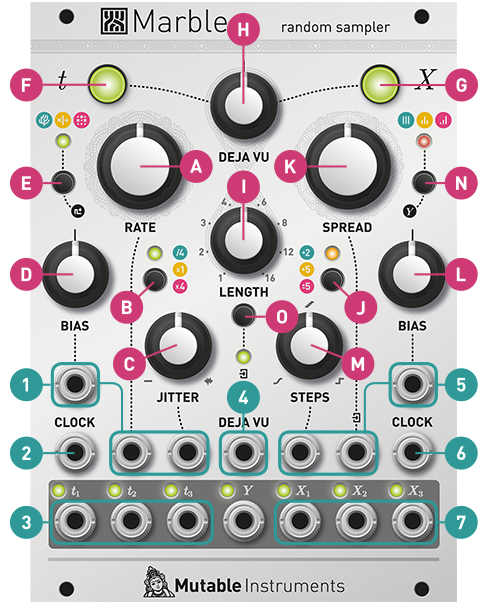
Key Points
There are too many functions, so I will stop down.
Percussive randomization
If you want to make a random like a drum, use 1 to 3 of t.
Please listen to it.All are modules in VCV Rack.
(In FL Studio, a little limiter is applied to increase the volume)
The rhythm pattern is a single Random Sampler that produces kick, hihat, and snare patterns.
(Move BIAS to control the pattern)
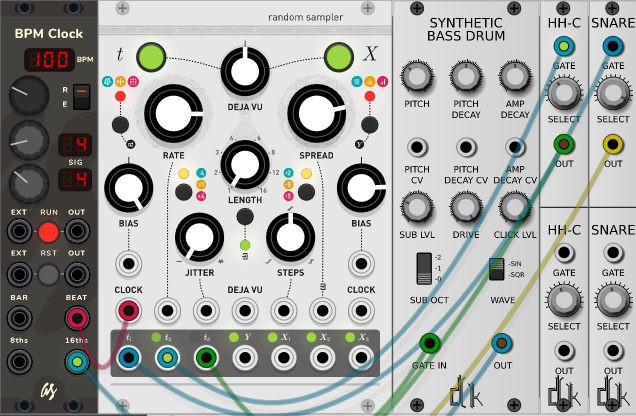
Since t2 has a clock, you can easily do it with 4 kicks or 16 minutes of hi-hat.
(Distributed to t2 and t1 the same number of times based on t3.)
If you connect the Clock, you can set it to 8 minutes or 16 minutes while synchronizing with A.
This timeBYou can change the base clock with.
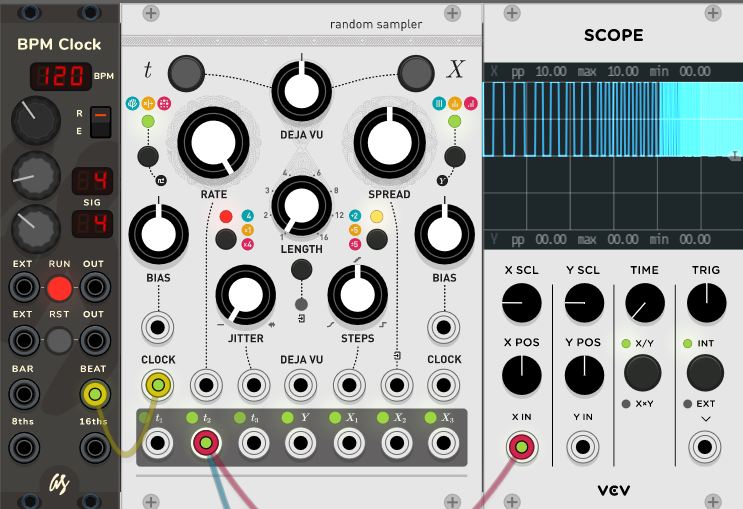
Raising C gives a swing-like effect.
The DEJA VU knob on the H does a very interesting job.
This allows you to change the probabilities of t1 and t3, and you can loop with a fixed probability.
From 7 o'clock to 12 o'clock, the H knob randomly sorts by t1 and t3.
The H knob will not be newly generated at 12 o'clock and will loop.
From 12 o'clock to 5 o'clock, it jumps randomly in the loop, so variations are born.
When you get the pattern you like, turn the H knob at 12 o'clock, set it from 12 o'clock to 5 o'clock, and then set it back at 12 o'clock.
t GENERATOR
The t-generator produces a random gate by generating a jittery master clock (output at t2) and deriving from it a stream of two random gates output at t1 and t3.
A.12 BPM at 120 o'clock clock rate.
B.Clock range Divides or multiplies the clock rate by 4.
C.Amount of Clock Timing Randomness – Simulates an instrumentalist who is perfectly stable, catching up late, and then ... completes the confusion.
D.bias.Controls whether the gate is more likely to occur at t1 or t3.There are several ways to select the master clock with the [E] button and divide it into t1 and t3.
A coin is thrown for each pulse of t1 to determine whether the pulse is passed to t3 or t2. BIAS manages the fairness of the coin toss.
t XNUMX and t XNUMX are generated by multiplying and dividing t XNUMX at random ratios, respectively.To reach the extreme ratio, turn the BIAS knob fully clockwise or counterclockwise.
Following the same kind of regularity as the kick / snare drum pattern, the trigger alternates between T1 and T3.
1. BIAS, RATE (with V / O scaling), and JITTER CV inputs.
2.External clock input.The clock signal patched to this input replaces the internal clock.In this case, the RATE knob and CV input are reused as frequency division control and the jitter setting is applied to the external clock.
3.Gate output.
Hold down the [E] button and turn BIAS to adjust the gate length from 1% to 99%, or turn JITTER to adjust the gate length randomization (deterministically to completely random).
DEJA VU SECTION
H.Random determination from the past / Probability of voltage recirculation:
From 7:12 to 0:1, this probability goes from XNUMX (fully random) to XNUMX (lock loop).
At 12 o'clock, the module doesn't generate any new random data, so it gets stuck in a loop.In this case, the lit pushbuttons [F] and [G] will blink.
From 12:5 to 0:1, the probability of randomly jumping in a loop is XNUMX to XNUMX.
Therefore, at 5 o'clock, the module randomly sorts the same set of decisions / voltages.
I.You can get lengths of 5, 7, 10, and 14 by setting knobs between the tick marks printed on the loop length panel.
4.Dejav CV input.
X GENERATOR
J.Output voltage range 0 to + 2V, 0 to + 5V or -5 to + 5V.
K.Width and shape of the probability distribution When turned counterclockwise from 12 o'clock, the voltage is more and more concentrated near the center of the range.A constant voltage is output all the way counterclockwise. At 12 o'clock, they follow the curve of the bell – most likely to occur near the center, but can reach extremes. At 2 o'clock, they have the same probability of occupying the entire voltage range.Beyond this point, extremums are more likely to occur.Fully clockwise, only the minimum and maximum voltages are possible, and X 1, X 2, and X 3 are random gates.
L.Tilt the distribution bias distribution to low or high voltage.Think of this as a probabilistic equivalent of offset.Instead of shifting the voltage up or down, it biases the decision below or above the voltage range.
The figure below shows the distribution of output voltages with a pink histogram.The tallest bar corresponds to the most likely result.The teal oscilloscope is an example of an output voltage sequence.
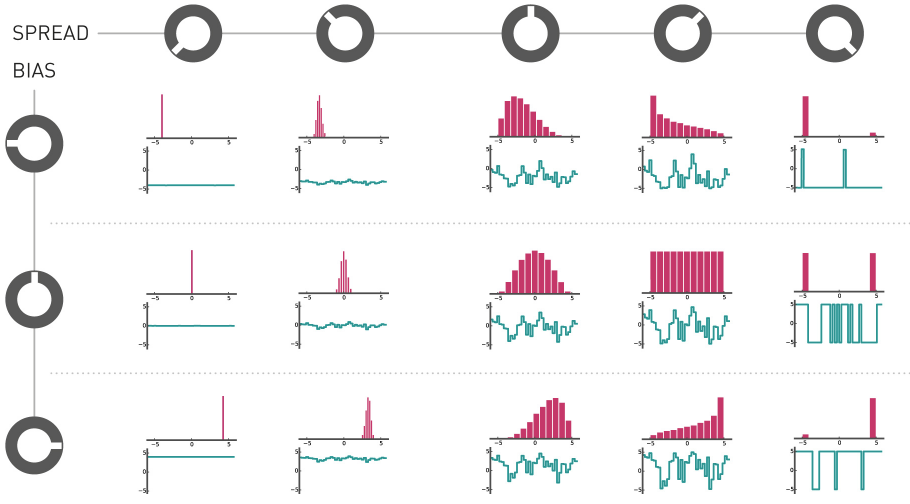
M.Horizontal and vertical "stepiness" of the generated voltage. At 12 o'clock, generate a typical S & H step. Turn CCW to create smooth edges, then random lines, and then smooth random curves. Turn CW to quantize the generated voltage into a scale, then gradually remove the scale of that note until only the root note remains.
N.Controls how the outputs X1, X2, X3 react to the settings dialed with the knobs [K], [L], [M] – it is possible to get different kinds of random voltages from the three outputs. ToDiversity is fun!
 All channels follow the control panel settings.
All channels follow the control panel settings.
 X2 follows the control panel, and X1 and X3 take opposite values.For example, if STEPS is fully CW, X1 and X3 will be smooth and X2 will be quantized to the root note and its octave.
X2 follows the control panel, and X1 and X3 take opposite values.For example, if STEPS is fully CW, X1 and X3 will be smooth and X2 will be quantized to the root note and its octave.
 X 3 follows the control panel, X 1 reacts in the opposite direction, and X 2 always stays in the middle (steep, unbiased, bell curve).
X 3 follows the control panel, X 1 reacts in the opposite direction, and X 2 always stays in the middle (steep, unbiased, bell curve).
O.External processing mode
5.Step, spread, bias CV input.
6.External clock input.With the patch applied, all three outputs follow the same external clock, rather than being clocked by the three outputs from the t section.
7.CV output.
Y GENERATOR
By default, the Y generator is a smooth full range (-5V to + 5V) random source, clocked at 2/1 the rate of X16.These settings can be changed by holding down the button and holding down the [N] button while adjusting the RATE (division factor for X2, 1/64 to 1), SPREAD, BIAS, and STEPS. The Y output is not affected by the DEJA VU settings.

Summary
The boss is a little too strong to catch up with my understanding at all.
The X GENERATOR part also has a lot of functions.I will post a demo and screen capture.
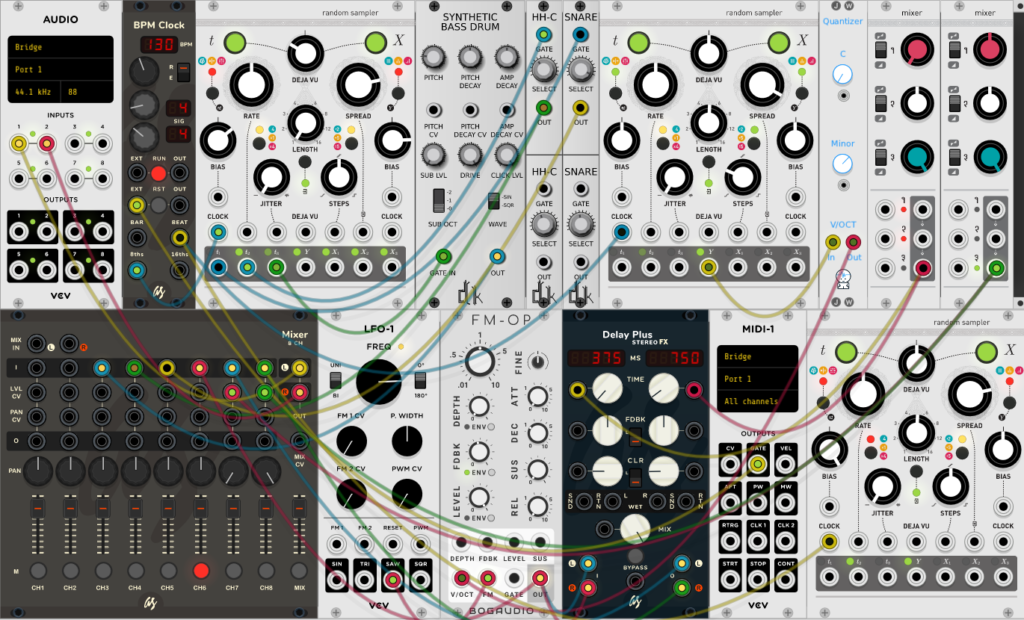
This article will be rewritten.
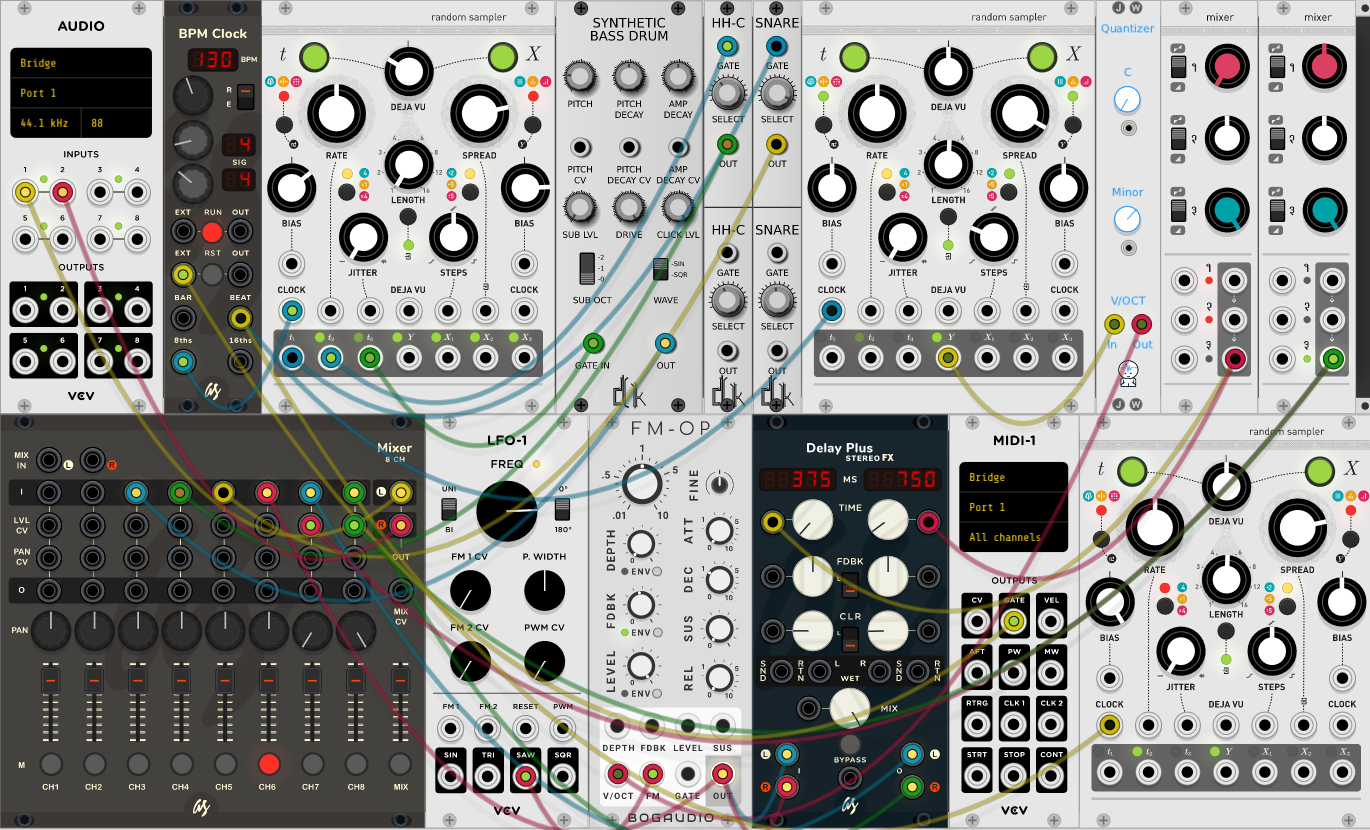


Comment